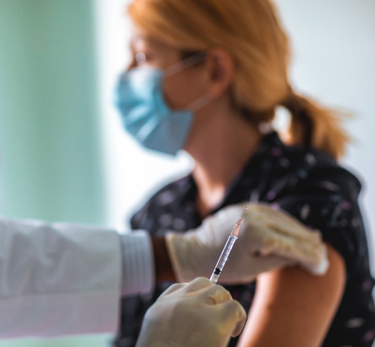County officials say: Stay home on New Year’s Eve
ALBANY COUNTY — On the morning of New Year’s Eve, the county’s executive and health commissioner urged residents to ring in the new year at home, celebrating only with the people who share their household.
The press conference began with County Executive Daniel McCoy announcing that five more residents have died of the COVID-19, making December, with 63 deaths, the virus’s most deadly month. The former county record was set in May, with 55 deaths, in the midst of the springtime surge, back when fewer treatments were available.
The latest casualties were two women in their nineties, a man in his nineties, a man in his eighties, and a woman in her seventies.
This brings the county’s COVID-19 death toll to 223.
“I know it’s New Year’s Eve; it’s a big night,” said McCoy. “Stay home to celebrate … Your actions … will affect us through the month of January.
McCoy went on, “We’ve seen the coronavirus wreak havoc across the globe with the loss of nearly 2 million lives. No place has been spared, including Albany County where COVID-19 has taken hundreds of county residents in a span of nine months.”
Although vaccination has begun, McCoy said, “It is critical we band together as one community for, together as one, we can beat the virus. Together as one, we can protect our community. Together as one, we can save the lives of our loved ones. So please join us. Let’s stand united and take the vaccine when it’s available.”
Polls show that 63 percent of Americans now are willing to take the vaccine, McCoy said, compared to 45 percent a few months ago. “But,” he added, “we still need to educate ourselves.”
Earlier this month, Anthony Fauci, the nation’s top infectious-disease specialist, had told Governor Andrew Cuomo during a press conference, “When you have 75 to 80 percent of the people vaccinated, you have an umbrella of protection over the community that the level of community spread will be really, really very low.”
Fauci anticipated that wouldn’t be until the end of next summer.
Albany County Health Commissioner Elizabeth Whalen said that, with COVID-19 cases at their peak, her department is at its busiest time, doing case investigations.
She said it is likely the county’s health department will get its first shipment of vaccines next week. Since the majority of her staff is doing time-intensive investigations, Whalen said, it is likely, rather than daily vaccine clinics, her staff will hold “larger clinics over shorter periods of time.”
She said the tiered system set up by the state, following guidance from the Centers for Disease Control and Prevention, on who will get vaccinated will be strictly adhered to. Public-facing health-department staff and the county’s medical reserve corps, which will assist with vaccinations, will be eligible for the vaccine.
On Thursday morning, Whalen said, she visited a POD, or Point of Dispensing, set up by Albany Medical Center, the regional hub, to give vaccinations. “They are getting through people quickly,” she said.
So far, about 18,000 residents in the eight-county Capital Region have been vaccinated, Whalen said.
She said of the vaccine, “We’re excited about this. This is what we’ve been waiting for. This is what we’ve been training for. This does signal the beginning of the end but it is not a time to let our guard down. We still predict that January will be a worse month than December.”
Whalen reiterated the need, even for people who have been vaccinated, to continue to: avoid gatherings, wash hands, wear masks, and maintain social distancing.
“For now, the guidance has not changed ...” Whalen said. “COVID is still causing a great deal of sickness … We are seeing hospitalizations and deaths every day.”
Newest numbers
Statewide, according to figures released by the governor’s office on Thursday, 403 Capital Region residents are hospitalized with COVID-19, which is 0.04 percent of the population and leaves 25 percent of the region’s hospital beds available.
Only one of the state’s 10 regions has a worse rate: Central New York at 22 percent. Also, the Mohawk Valley has the same percentage of beds available: 25 percent.
Statewide, 0.04 percent of New Yorkers are hospitalized with COVID-19, leaving 31 percent of hospital beds available.
The Capital Region continues to have the lowest percentage of intensive-care unit beds available, at 19 percent; 200 of the region’s 239 ICU beds are currently occupied.
Statewide, 31 percent of ICU beds are available.
The COVID-19 infection rate, as a seven-day average, for the Capital Region was the third highest in the state at 9.13 percent. Statewide, the positivity rate was 6.83 percent.
In Albany County, as of Thursday morning, there have been 11,448 confirmed cases of COVID-19 with 256 new cases, McCoy said.
Of the new cases, 205 did not have a clear source of infection identified, 35 had close contact with someone infected with the disease, five are health-care workers or residents of congregate settings, and one reported traveling out of state.
The five-day average for new daily positives increased to 220.2 from 218. There are now 1,647 active cases in the county, up from 1,547 on Wednesday.
The number of county residents under quarantine decreased to 2,956 from 3,093. So far, 37,383 residents have completed quarantine. Of those, 9,801 had tested positive and recovered. That is an increase of 144 recoveries since Wednesday.
Eleven more residents were hospitalized overnight. There are 120 county residents currently hospitalized from the virus – a net decrease of nine. There are now 20 patients in the ICU, down from 21 on Wednesday.
McCoy noted that hospitalizations in the county have been trending up since Dec. 24 and that, throughout December, 396 residents have been hospitalized, accounting for 42 percent of all those hospitalized since March.


